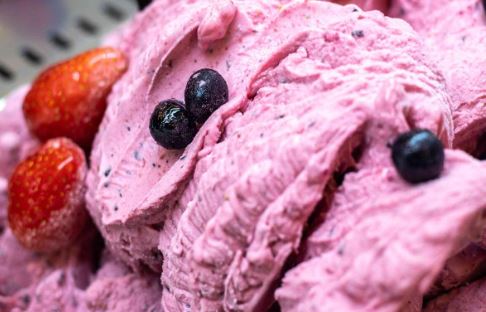
Whether you’re having an over-the-top ice cream sundae, a serving of apple pie à la mode, or just sneaking a spoonful of mint chocolate chip straight out of the carton, a scoop of your favorite frozen dessert can do no wrong. But if you’ve ever found yourself in the freezer aisle wondering what’s the difference between ice cream and gelato- you’re not alone!
Sure, ice cream and gelato appear to be similar- they’re cold, sweet, no-bake desserts that taste great with a drizzle of hot fudge. But once you give each one a try (and we do encourage you to taste both!), you’ll notice right away that they’re not the same at all. Both ice cream and gelato are made with similar ingredients (a custard base that includes milk and sugar), but that’s about all they have in common.
Each sweet treat has its distinct history, ways of being produced, and unique qualities from flavor to texture. One isn’t necessarily better than the other. When it comes to gelato vs. ice cream, it just depends on your personal preferences. Here’s a fun idea: set up a DIY ice cream bar with both gelato and ice cream then taste for yourself! If you’re anything like us, you’ll love both equally, in their own right! So, what’s the difference between ice cream and gelato? Read on to find out more!
What is gelato?
Gelato is richer, denser, and smoother relative to American ice cream. The term gelato means ice cream in Italian. In Italy, frozen desserts date back thousands of years, but it wasn’t until the Renaissance that gelato, as we know it today, became popular. Similar to ice cream, gelato is made from a custard base of milk, cream, and sugar. The difference lies in the proportions of each with gelato having more milk (and less cream) compared to ice cream.
Gelato also doesn’t usually contain egg yolks the way that ice cream does. Along with these different ingredients and proportions, gelato is also made distinctly. Italian gelato is often described as being dense. This comes from the process in which it is churned, at a much slower speed compared to ice cream. Once the gelato is churned, it’s stored and served at a slightly warmer temperature that’s not completely frozen.
These days, gelato comes in a variety of flavors and if you find yourself at a gelateria (Italian for gelato shop), you’ll be amazed at the dozens of heaping mounds of gelato behind the case. Looking for a good place to start? You can’t go wrong with the classics, like chocolate, hazelnut, pistachio, or Stracciatella (a sweet cream flavor with chocolate chips mixed in).
How is gelato different from ice cream?
Despite being practically cousins, ice cream and gelato have some significant differences that set them apart. Ice cream, which first came to America in the 1700s, found its footing as a classic American dessert and became the basis for recipes like ice cream floats, ice cream sandwiches, banana splits, and even ice cream cakes.
Ice cream is usually described as creamier and fluffier than gelato. Its custard base contains egg yolks and more cream than milk, which means it has more fat (at least 10 percent fat compared to gelato’s 5 to 7 percent fat). Unlike gelato, ice cream is whipped at a high speed in an ice cream maker which makes it airier and less dense. To top it off, ice cream is usually served frozen, which makes the flavors less pronounced, but also makes it great for a hot summer day.
The Flavor and Texture
Stop into any ice cream parlor or peek inside the case at the supermarket, and you will witness the expansive array of flavors, from traditional vanilla and coffee ice creams to somewhat unusual flavors such as sweet basil and sweet potato. But when it comes to gelato, the flavor profile is much narrower.
There are a few classics you’ll find in gelato- vanilla, chocolate, hazelnut, and stracciatella (vanilla with crunchy chocolate pieces), as well as pistachio, tiramisu, and a variety of fruit flavors, but not necessarily the type of combinations you see in the ice cream aisle. The differences in both treats’ compositions and the way they are stored affect the way they taste and feel in your mouth.
Fat coats the tongue, creating a layer between the taste buds and the food you are eating, and colder food numbs the tongue a bit, making it more difficult to taste the food. Since gelato has less fat and is warmer than ice cream, the flavors come through more and are more intense. These factors also make for a smoother consistency whereas ice cream has more of a fine crystal texture.
The ingredients
Two of the main ingredients in both ice cream and gelato are milk and cream, but it is the amount of each that results in differing desserts. As the name implies, “ice cream” contains more cream than milk, whereas gelato is made with a greater proportion of whole milk to cream.
Another ingredient that distinguishes the two is eggs; ice cream includes egg yolks while gelato is (most often) completely void of eggs. These differing measurements and ingredients affect the amount of fat in each dessert, as well as the mouthfeel (the texture of the food in your mouth as you eat it). Legally, ice cream has to have a minimum of 10 percent fat; gelato contains only 5 to 7 percent fat.
The Process
It is not just the ingredients that separate the two, it is also the way that each is made. Ice cream and gelato must be churned to create that creamy, scoopable goodness, but it is the speed at which they are churned—and the resulting amount of air incorporated—that is different.
Gelato is churned at a slower speed than ice cream, which creates a denser consistency since less air is whipped into the mixture. Gelato contains about 25 to 30 percent air, while ice cream can contain as much as 50 percent air. Once the ice cream and gelato are made, they are stored at certain temperatures to maintain the right consistency.
Ice cream is typically served frozen, around 0 F, whereas gelato is typically stored and served at a slightly warmer temperature, around 15 F. This means gelato is not quite completely frozen, making the texture softer and silkier than ice cream.
Gelato: Dense and Intense
Gelato is the Italian word for ice cream. It starts with a similar custard base as ice cream but has a higher proportion of milk and a lower proportion of cream and eggs (or no eggs at all). It is churned at a much slower rate, incorporating less air and leaving the gelato denser than ice cream. Gelato is served at a slightly warmer temperature than ice cream, so its texture stays silkier and softer. Because it has a lower percentage of fat than ice cream, the main flavor ingredient shines through.
Ice Cream: Fluffy and Full of Fat
Ice cream is a frozen dairy dessert made of milk, cream, sugar, and (typically) egg yolks. Traditionally, French-style ice cream contained egg yolks and was richer than American-style ice cream, which didn’t initially contain eggs. However, American ice cream has now evolved to also include the yolks. The ingredients in ice cream are first cooked together into a rich custard.
After the custard base is cooled, it’s churned at a fairly high speed to incorporate air and increase its volume (cheaper ice creams tend to have more air whipped into them). Ice cream is served at a fairly cold temperature that makes scoops hold together, and the finished product is smooth, light-textured, and creamy.
Which is healthier: gelato or ice cream?
There’s no denying that both ice cream and gelato are sweet indulgences. Neither is going to help you lose weight. While ice cream usually has more calories and fat, both desserts contain sugar. Let’s face it: We’re not eating either for their healthy qualities.
So, which should you choose?
This is totally up to you! The difference between ice cream vs. gelato is a personal preference. If you prefer something colder and creamier, go for ice cream. If you want to try something rich and silky, try gelato. You can’t go wrong either way!




